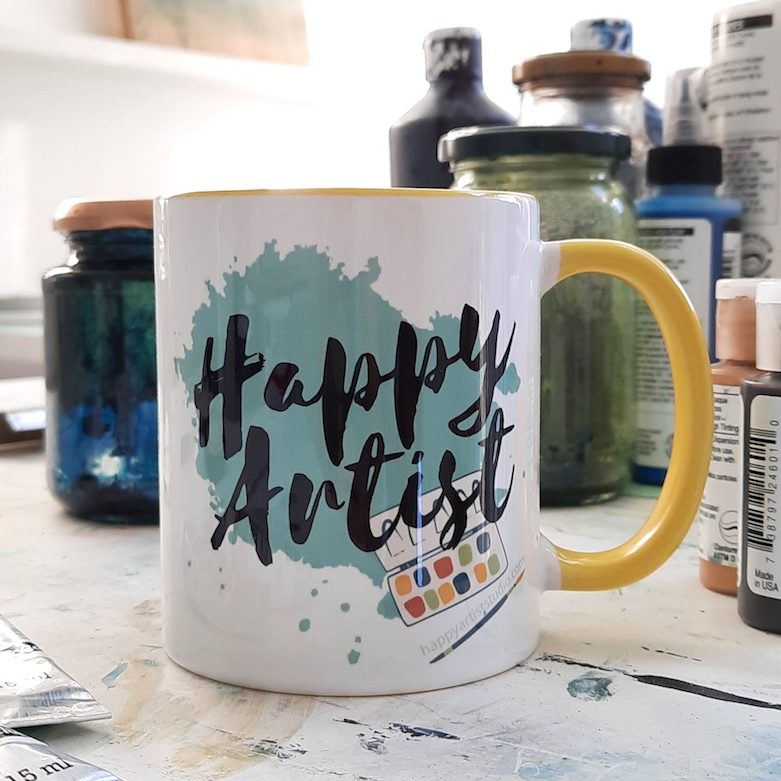
Probably one of the top three questions or ‘issues’ I’ve come across in my teaching life over the years is something that sounds like some or all of this:
“I can’t seem to narrow down my interests to a single way of making art. I’m far too curious to just choose one thing and stick to it.
My art ends up being all over the place – I just love to do a bit of everything. Does that mean I’m wrong? That I’m not a ‘real artist’? Why can’t I seem to narrow it down? Do I have to? How can I do that?
It feels so limiting, but I really want to know what’s unique to me about my art.”
Sound familiar?
Let’s take a look at something for a sec.
Here’s a list of things – materials, approaches, ideas, genres – I’ve explored in pursuit of my art:
- oils*
- acrylics*
- watercolours*
- soft pastels*
- oil pastels
- gouache
- inks*
- earth pigments*
- mixed media*
- spray paint
- stamps and stencils
- monoprinting
- silkscreen printing
- etching
- life drawing
- collage
- charcoal
- realism
- abstract*
- landscape*
- portrait
- figurative
- still life
- intuitive art
- art journaling
- sculpture
- ceramics
- weaving
- eco printing
- cyanotypes
- carving*
- free machine embroidery
- encaustic
- asemic writing
- tiny paintings*
- large paintings*
- canvas*
- paper
- wood panel*
- sketchbooks
- tiny detailed work*
- big gestural work*
- neon colours
- black and white
- mixing a palette*
- using paint straight from the tube*
- land art
- pen and ink drawing*
- ink and brush painting* {on rice paper}
And that’s just what I can remember!
I’ve starred everything I use in my current practice too.
Some of these things have stuck, some have been temporary way stations while I worked out what was true for me – if anything – about each thing.
Some I’ve gone back to over and over in different ways, some have woven together and evolved into new things.
My point is, of COURSE you want to try all the things! It’s the nature of creativity.
Our innate everybody-has-it-no-exceptions natural creativity is curious; it wants to explore and play and experiment and dabble.
It’s not wrong! It doesn’t mean you’re not a ‘real artist’ if you don’t want to – or don’t seem able to – do just one thing.
{And I’d also add that it doesn’t go away if and when you DO settle on a single focus. And that’s a good thing!}
Heaps of artists throughout history – even those known for ‘one thing’ – have pursued all sorts of creative and artistic avenues.
Many of the artists whose work we can immediately visualise when we hear their names started firmly entrenched in traditional and realistic paintings – Matisse, Picasso, and Mondrian among them. {And Picasso never stopped exploring different avenues of creative self expression!}
I would argue that the ‘multi-passionate’ approach only enriches your understanding, and your truest work.
Which is in there, by the way, and it’s probably a mix of things itself, even if they end up coming out as ‘one thing’.
I’m not rich or famous, but I am a happy artist, so if you need an example, or permission to try All The Things and let it unfold as it will, take another look at that long list above and use me!
In my experience and from observation, many artists come to a crossroads, sometimes a few years in.
They’ve tried a lot of stuff, they’ve made a lot of stuff, it’s all wild and free and very varied, and a tiny voice has started saying, “which is mine?”
We are inundated daily with inspiration – which all too often crosses that controversial line into influence and copying – from the beautiful double edged sword that is technology.
Instagram and Pinterest alone are rabbit holes of artistic gluttony, and it can be hard to sift through it all to the clarity of our own unique vision.
I don’t want to give the impression that there is ‘a solution’ here.
Art isn’t like maths – there are no definitive right or wrong answers. There are only YOUR answers, and I know that’s very annoying to hear when you’re stuck in the maelstrom of wanting to do everything!
 I created the Happy Artist Studio, an online membership for artists, to help address the questions, so you’re ready for some help finding your own answers, it’s time to join us!
I created the Happy Artist Studio, an online membership for artists, to help address the questions, so you’re ready for some help finding your own answers, it’s time to join us!
We focus on the two pillars of a happy artist life – mindset and process, through monthly inspirations, a wealth of self study courses, and a lovely friendly community full of artists just like you, finding their way.
Click here to find out more and start creating your happy artist life too!







I so agree with you Tara. Trying out different things informs my art practice in an very important way. I try different techniques but it’s always about the same subject, ie figure art.
And even if I painted figures, still life or/and landscape it still wouldn’t be a problem, because after a while, there’s always something in the artist’s “language” that’s recognizable.
For example I can recognize your work regardless tools, techniques or subject matter. There’s something that is you in your work. This identifiable language is of course not necessarily there from the beginning, but it takes form after a while.
Try stuff out. No poet started writing poetry after learning to spell. It’s a long process of playing with genres, subjects, words, etc.
I’ve definitely seen you following this path Gina! Love the poet analogy too. 🙂